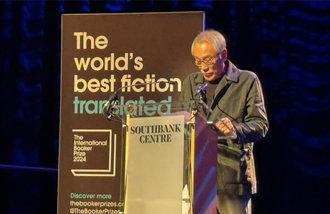Ethnic Korean Children from Japan Visit Seoul
Ethnic Korean Children from Japan Visit Seoul
Posted May. 04, 2004 20:56,
My name is Cho Seung-gui. I am a fifth grader at Tokyo Chosun Elementary School 5 and I want to be a robot doctor.
Childrens laugher wafted out of a sixth grade homeroom at Unbook Elementary School in Seoul on the afternoon of May 3. Their applause and curious faces were a welcome sign for important visitors, Park Ae-sil (13 years old), Han Yoo-hwa (13 years old), Lee Si-hong (12 years old) and Cho Seung-gui (12 years old).
These visitors are students from Tokyo Chosun Elementary School 5 and 6. Cho and Han are Chosun nationals, rendering them subject to the most severe discrimination in Japan. Park and Lee have a Korean nationality.
They came to Korea with two Japanese students as part of a four-day, three-night 2004 East Asian Peace Drawing Contest organized by North And South Korean Children Shoulder In Shoulder. They were afraid because this was the first trip they had ever taken without their parents. However, as the children said with a smile, There are many friends who speak the same language as ours.
Chosun national refers to Korean Japanese who have maintained their Chosun nationality by opting not to be naturalized or adopt a Korean nationality following the liberation of Korea from Japanese rule in 1945. Among Japans 1.2 million ethnic Koreans, there are 150,000 Chosun nationals.
As Japan has no diplomatic ties with North Korea, there is no nationality in the Democratic Peoples Republic of Korea or North Korea. The Chosun nationality has become synonymous with membership in the pro-North Korean Japan-residing Korean League. However, some ethnic Koreans chose the Chosun nationality, leaving them with a status no better than that of a refugee since they believe both Koreas to be their homeland.
Their vulnerable legal status as Chosun nationals was revealed during the childrens trip to Seoul. Park and Kim had to receive a temporary trip permit from the Korean government while the Japanese children had little problem coming to Seoul. Preparing documents and working through the process was hectic for the children.
I really like Korea, a saddened Han said. But because of the exhausting process, I am afraid I cannot visit again.
The children were excited. Han and Lee quickly shed their shyness and made friends with the other children. They made a V sign when they took a photograph together. Cho, who is known for always maintaining a serious face, began to dance when his favorite foods were served, making the children in the cafeteria burst into laughter.
When they talked about BoA, a popular teenage singer in Korea and Japan, their eyes sparkled. When they stopped at a large book outlet, things got briefly out of control when the children rushed to grab BoAs concert posters.
The power of our culture let the children connect with each from other across the wall, Seong Pil-nyeo, a 49-year-old fine arts teacher of Chosun nationality, said. I hope we all lead a fair life with the nationality of a unified Korea soon.
Cho who ended up buying a lacquer as a gift for his mother with the money he had saved for a robot said, I will come back as a robot doctor to a unified Korea. The children will leave Korea on May 5, Childrens Day. May 5 is also Boys day in Japan. The Girls Day is on March 3.
These children of Chosun nationality will think about their homeland and hometown as they travel over the Korean peninsula and the Japanese islands.
Yang-Hwan Jung Ji-Seong Jeon ray@donga.com verso@donga.com






